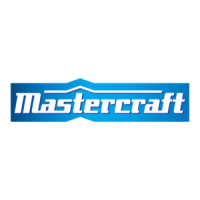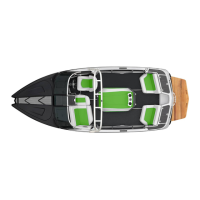
Do you have a question about the MasterCraft XT23 2017 and is the answer not in the manual?
| Brand | MasterCraft |
|---|---|
| Model | XT23 2017 |
| Category | Boat |
| Language | English |
General safety guidelines and precautions before operating the boat.
Specific safety rules and recommendations for operating the boat on the water.
Emphasizes the importance of continuous awareness for safety.
Guidelines for safely loading and distributing weight in the boat.
Requirements and guidelines for using PFDs on board.
Information on fire suppression systems and required fire extinguishers on board.
Precautions and actions to take in case of boat capsizing.
Procedures and safety measures to follow when grounding or hitting objects.
Safety guidelines for individuals in the water and participating in water sports.
Legal implications and dangers of boating under the influence of alcohol or drugs.
Guidelines for survival and heat escape when immersed in cold water.
Detailed features and specifications for the X20 model.
Detailed features and specifications for the X23 model.
Detailed features and specifications for the X46 model.
Detailed features and specifications for the X26 model.
Detailed features and specifications for the XStar model.
Detailed features and specifications for the ProStar model.
Detailed features and specifications for the XT20 model.
Detailed features and specifications for the XT21 model.
Detailed features and specifications for the XT23 model.
Detailed features and specifications for the NXT20 model.
Detailed features and specifications for the NXT22 model.
Detailed features and specifications for the NXT20 GE model.
Overview of the 7-inch video screen instrument panel for X and XT series.
Details of the instrument panel layout for the XStar model.
Overview of the instrument panel layout for the ProStar model.
Details of the instrument panel layout for the NXT series.
Explanation of engine gauges used in X and XT series, including speedometer and tachometer.
Explanation of the Ballast and Trim screen and its touch command functions.
Explanation of the Profiles screen for cruise control and user preferences.
Steps for creating a new rider profile for customized settings.
Steps for modifying existing rider profiles for customized settings.
Instructions on how to delete a selected rider profile.
Explanation of the Cruise control function and its preset rider profiles.
Controlling tab positions for trim tabs and surf tabs.
Controlling ballast fill and drain times for optimal performance.
Explanation of the Ballast and Trim screen and its soft key command functions.
Displays power distribution module information and faults.
Explanation of the engine oil pressure gauge and what low pressure indicates.
Information on the water temperature gauge and its normal operating parameters.
Operation and adjustment of Attitude Adjustment Plates and NXT Wake Shaping Devices.
Information on ballast systems, including types, purpose, and maintenance.
Operation and adjustment of trim controls for NXT Wake Shaping and Attitude Adjustment Plate.
Displays engine fault codes and descriptions, with corrective actions.
Information on the boat's fire suppression system and required extinguishers.
Operation and adjustment of the attitude adjustment plate for ride and performance enhancement.
Safe practices and procedures for fueling the boat's fuel system.
Importance of maintaining proper fuel levels to avoid engine and fuel system damage.
Information regarding ILMOR Marine Engines, including owner's manual and gasoline requirements.
Troubleshooting steps for fuel pump and relay issues.
Tasks to be completed before launching the boat, including safety and operational checks.
Critical break-in procedures for the engine and drive train to ensure longevity.
Pre-operation checks and familiarization with controls and indicators.
Step-by-step guide for starting the boat's engine, including safety switch and ignition key usage.
Guidelines for properly loading the boat onto the trailer, including weight limits.
Methods for preventing galvanic corrosion and protecting metal parts.
Measures to prevent corrosion on boats operated in salt water.
Specific care and maintenance procedures for boats used in saltwater.
Tasks to be completed before launching the boat, including safety and operational checks.
Procedures for inspecting the fuel system for leaks and changing the fuel filter.
Checks to perform after starting the engine, including battery charge and gauge readings.
Importance and operation of the emergency stop switch for operator safety.
Operation of the single-lever control for shifting gears and throttle.
Operation of the trim/tilt control for adjusting outboard motor position.
Understanding trailer load limits and the importance of proper weight distribution.
Dangers of improper weight distribution and how to correct it.
Explanation of trailer hitch types and proper selection.
Importance and proper attachment of safety cables and breakaway cable.
Securing and resetting the breakaway cable for trailer brake activation.
Step-by-step guide for connecting the trailer to the tow vehicle.
Importance of checking and properly torquing lug nuts to prevent wheel separation.
Operation and maintenance of the trailer's disc brake system.
Proper brake fluid types and replacement schedule to prevent failure.
Outlines warranty periods for structural components, gel coat, and other parts.











